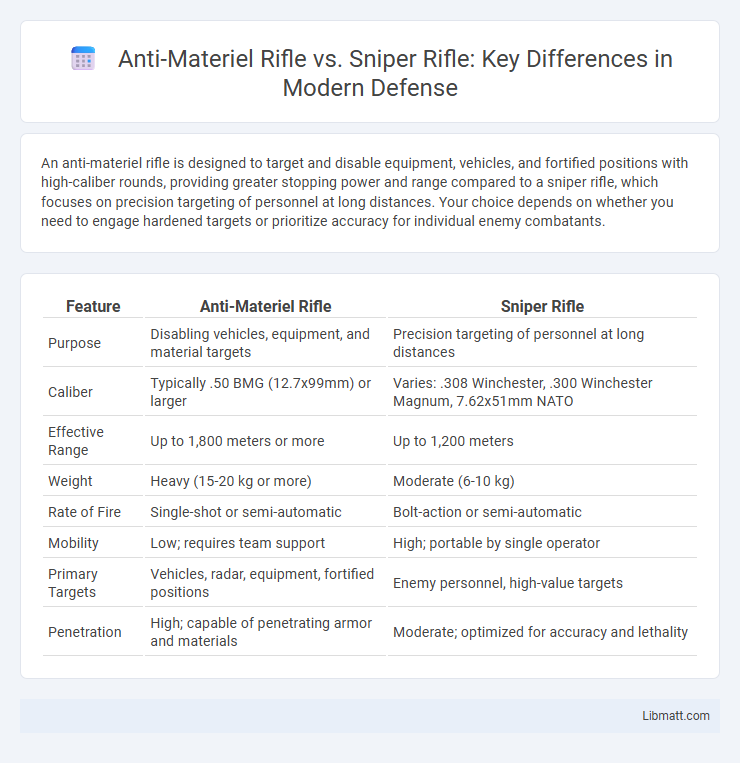An anti-materiel rifle is designed to target and disable equipment, vehicles, and fortified positions with high-caliber rounds, providing greater stopping power and range compared to a sniper rifle, which focuses on precision targeting of personnel at long distances. Your choice depends on whether you need to engage hardened targets or prioritize accuracy for individual enemy combatants.
Table of Comparison
| Feature | Anti-Materiel Rifle | Sniper Rifle |
|---|---|---|
| Purpose | Disabling vehicles, equipment, and material targets | Precision targeting of personnel at long distances |
| Caliber | Typically .50 BMG (12.7x99mm) or larger | Varies: .308 Winchester, .300 Winchester Magnum, 7.62x51mm NATO |
| Effective Range | Up to 1,800 meters or more | Up to 1,200 meters |
| Weight | Heavy (15-20 kg or more) | Moderate (6-10 kg) |
| Rate of Fire | Single-shot or semi-automatic | Bolt-action or semi-automatic |
| Mobility | Low; requires team support | High; portable by single operator |
| Primary Targets | Vehicles, radar, equipment, fortified positions | Enemy personnel, high-value targets |
| Penetration | High; capable of penetrating armor and materials | Moderate; optimized for accuracy and lethality |
Definition of Anti-Materiel Rifle
An anti-materiel rifle is a high-caliber firearm designed to target and disable equipment, vehicles, and fortifications at long ranges, unlike sniper rifles which prioritize precision against human targets. These rifles often chamber rounds like the .50 BMG, delivering immense power capable of penetrating armor and reinforced structures. Your choice between an anti-materiel and sniper rifle depends on whether engaging material targets or precise, long-distance human targets is the primary objective.
Definition of Sniper Rifle
A sniper rifle is a precision firearm designed for long-range accuracy and typically chambered in calibers suitable for targeting individual personnel. These rifles feature high-powered optics, adjustable stocks, and enhanced barrel designs to maximize shot stability and precision at extended distances. Unlike anti-materiel rifles, sniper rifles prioritize accuracy over stopping power and are optimized for tactical engagements against human targets.
Core Design Differences
Anti-materiel rifles feature larger calibers, typically ranging from .50 BMG to 20mm, designed to engage and disable vehicles, equipment, and fortified targets with high kinetic energy and armor-piercing capabilities. Sniper rifles generally use smaller calibers like 7.62mm or .300 Winchester Magnum, optimized for precision targeting of personnel with enhanced accuracy, range, and ballistic efficiency. The core design differences lie in barrel length, recoil mitigation systems, and ammunition type to fulfill their distinct operational roles.
Caliber and Ammunition Comparison
Anti-materiel rifles typically fire large-caliber rounds such as the .50 BMG (12.7x99mm) or even larger, designed to penetrate armor and disable vehicles or equipment, whereas sniper rifles usually use smaller calibers like the 7.62x51mm NATO or .308 Winchester, optimized for precision and long-range targeting of personnel. Ammunition for anti-materiel rifles often includes armor-piercing and incendiary rounds, providing substantial stopping power against hardened targets, while sniper rifle ammo emphasizes match-grade bullets for accuracy and minimal wind drift. Your choice between the two depends on whether you need to engage heavily armored materiel or prioritize precision shooting against individual targets.
Primary Tactical Roles
Anti-materiel rifles are primarily designed to target and disable equipment such as vehicles, radar systems, and fortified positions, making them essential for disrupting enemy infrastructure. Sniper rifles focus on precision engagements against personnel at extended ranges, emphasizing accuracy and concealment in tactical operations. Your choice between the two should align with the mission objective, whether it requires neutralizing enemy assets or eliminating high-value targets.
Effective Engagement Range
Anti-materiel rifles typically have an effective engagement range between 1,500 to 2,000 meters due to their larger caliber and specialized ammunition designed to disable equipment and vehicles. Sniper rifles generally demonstrate effective accuracy within 800 to 1,200 meters, optimized for targeting personnel with high precision. These engagement ranges highlight the anti-materiel rifle's role in long-distance, hard-target penetration compared to the sniper rifle's emphasis on precision shooting at moderate distances.
Accuracy and Precision Capabilities
Anti-materiel rifles and sniper rifles both offer high levels of accuracy and precision, but they serve different purposes. Sniper rifles prioritize pinpoint accuracy for engaging human targets at long distances, often within sub-MOA (Minute of Angle) precision standards. Anti-materiel rifles provide reliable precision with slightly reduced accuracy compared to sniper rifles but excel in delivering immense kinetic energy to disable equipment and vehicles beyond typical combat ranges.
Portability and Handling
Anti-materiel rifles are typically larger and heavier, weighing between 25 to 35 pounds, which reduces portability and makes handling cumbersome during extended operations. Sniper rifles, on the other hand, usually weigh between 10 to 15 pounds, offering greater maneuverability and ease of transporting over various terrains. The compact design and lighter weight of sniper rifles facilitate quicker target acquisition and improved handling in dynamic combat environments.
Common Military and Law Enforcement Applications
Anti-materiel rifles are primarily used in military operations to disable vehicles, equipment, and fortified targets at long ranges due to their high-caliber rounds and armor-piercing capabilities. Sniper rifles, favored by both military and law enforcement, excel in precision targeting of enemy personnel, hostage situations, and counter-sniper roles, where accuracy and stealth are paramount. Your choice between these rifles depends on mission requirements, with anti-materiel rifles suited for heavy-duty impact and sniper rifles optimized for tactical precision.
Key Advantages and Disadvantages
Anti-materiel rifles excel in long-range engagement against vehicles and fortified targets, offering superior armor penetration with large-caliber rounds but are often heavier and produce significant recoil, limiting mobility and rapid follow-up shots. Sniper rifles provide greater precision for human targets, lighter weight for easier maneuverability, and faster rate of fire, though they typically lack the destructive power needed for disabling equipment or hardened structures. Your choice between the two depends on mission requirements, balancing the need for target type versatility versus portability and precision.
anti-materiel rifle vs sniper rifle Infographic

 libmatt.com
libmatt.com